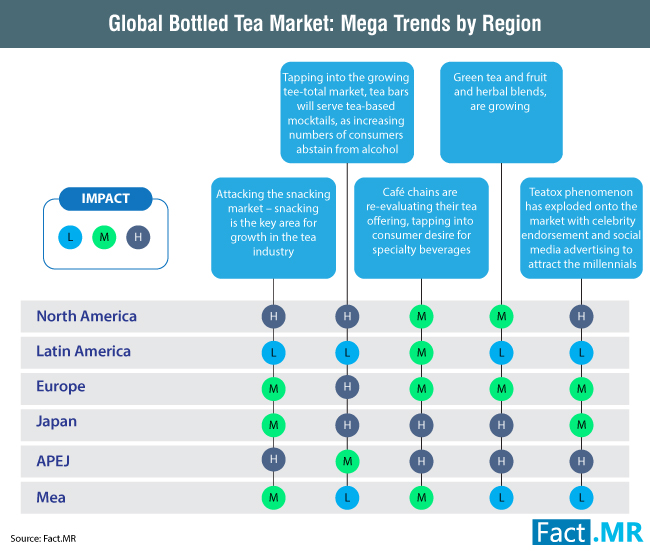Global consumption of bottled tea is expected to surpass 41 Mn Liters, growing at a Y-o-Y of 3.4% in 2018 over 2017. Overall growth of the Bottled Tea Market can be attributed to,
Increasing appetite for specialty teas and their easier availability
Health conscious consumers preference for healthful tea beverages
Millennials’ developing palate for different RTD bottled tea flavors
Accessibility of bottled tea across various sales channels
“The bottled tea marketplace is heavily impacted by evolving consumer sentiments wherein vendor revenues dwindled half a decade ago on the back of a contagious low- or no-sugar beverage trend. As manufacturers ramped up the production of no-sugar tea varieties, the bottled tea market has surpassed US$ 47 Bn in 2017 and the status quo is highly likely to continue in 2018,” says a senior analyst at Fact.MR.
Request For Sample Report- https://www.factmr.com/connectus/sample?flag=S&rep_id=2371
The study opines that the demand for still variety of bottled tea will witness over 35 Mn Liters consumption globally in 2018. However, sparkling tea revenues are set to grow at a 6% Y-o-Y in 2018 over 2017. This rapid expansion can be attributed to growing demand among millennials and generation Z for sparkling tea, in particular, sparkling ice tea. The bottled tea marketplace is witnessing manufacturer investments in introducing new varieties of sparkling ice tea.
Conventional bottled tea has remained the primary choice among tea lovers until the arrival of organic tea variant. Fact.MR finds that the consumption of conventional variants will hold over 80% of the total bottled tea consumption in 2018. However, demand for organic variants is growing rapidly wherein consumption will increase over 4 Mn Liters in 2018 over 2017.
Fact.MR study finds 30% of bottled tea consumed to be black tea in 2018. Black tea continues to remain the highly popular tea blends and is consumed for its potential health benefits.
Fact.MR estimated green tea occupied one-fourth of the global bottled tea consumption in 2017. Traditional recognition of green tea as a medicine and a higher concentration of antioxidants, particularly epigallocatechin gallate (EGCG) continue to encourage green tea consumption globally.
Browse Full Report on Bottled Tea Market with TOC- https://www.factmr.com/report/2371/bottled-tea-market
The retail shelves of multiple stores and online channels now have a variety of organic bottled tea. Staying ahead of consumer demand, manufacturers of organic bottled tea are actively engaged in expansion activities.
HORECA, according to the Fact.MR study continues to present a significant demand for bottled tea. Consumer packaged goods (CPG) industry is significantly investing in HORECA on the back of growing consumer sentiments such as eating outside home and preference for ready-to-eat foods. The study also finds that modern trade will be the next preferred sales channel for bottled tea among consumers.
APEJ Helms Bottled Tea Consumption, Held 40% of volume Sales in 2017
Globally, the bottled tea consumption remains concentrated in the APEJ region. With the region’s populous nature and its significant millennial population, APEJ accounted for two-fifth of the global bottled tea consumption in 2017. Fact.MR estimates that Greater China consumed nearly 43% of the APEJ bottled tea consumption. According to Fact.MR, the popularity of black tea in the region has significantly contributed to the steady rising bottled tea consumption.
The bottled tea market growth, according to Fact.MR will continue its upwards steady trend on the back of increasing preference for ready-to-eat beverages and consumer-driven product innovations. As manufacturers focus on expanding their global footprints, bottled tea popularity is here-to-stay in the future.
The Fact.MR report tracks the bottled tea market for the period 2018-2027. According to the report, the bottled tea market is projected to grow at nearly 4% CAGR through 2027.



